Almost everyone on the web has seen this by now but if you haven’t, take a look. It’s a classic example of don’t-get-mad-get-even.
[youtube]http://www.youtube.com/watch?v=5YGc4zOqozo[/youtube]
The Original New Music Community
Almost everyone on the web has seen this by now but if you haven’t, take a look. It’s a classic example of don’t-get-mad-get-even.
[youtube]http://www.youtube.com/watch?v=5YGc4zOqozo[/youtube]

And you thought the master was gone?… Nooo no no, not that easy… His foundation and famous summer courses in Kürten continue — even stronger, if that’s possible. Starting today, July 10th, and continuing every day through July 26th, at 8pm there’s a concert featuring Stockhausen’s work (interspersed with course participants, which spiritually is very much the same thing). It’s a crazy insane compendium of S.’s music, spanning decades; there’s just too much to put on the main page, so I’ll list it all after the jump (and why the hell isn’t German Radio or the BBC camped out for this one?? This isn’t a ‘course’; this is more of a WoodStockhausen!). But before that I’ll quote the official press release:
Karlheinz Stockhausen is alive! His after-life is never ending and more comprehensive than ever: The Kürten Stockhausen Courses and Concerts were Stockhausen’s favourite project and have gained even larger dimensions after his death. The stream of students who want to interpret Stockhausen’s inheritance in a new way, and who for that reason pilgrim from all over the world to Stockhausen’s hometown in the “Bergische Land” every summer, is not ebbing – on the contrary. The same applies to listeners and music lovers. Many of them stay with host families in Kürten. The duration of the concert series has been extended from nine to 17 days. The programme includes electronic sounds, as well as piano, singing, violin, viola, piccolo, basset horn, English horn, tam-tam or percussion. The new version of PROZESSION for computers is brand new. The concerts presented are the highest level and are astoundingly full. And, they are augmented by special lectures: Renowned musicologists speak on Stockhausen’s life and work. (more…)

(Thanks to Kevin Austin, who runs the Canadian Electroacoustic Community e-mail list, for pointing this one out):
Every serious classical listener/collector has spent time probing through the hiss, pop and crackle of early monophonic 78 and 33 rpm recordings; though the sound is tinny and boxed in, they love the magical feeling of somehow being brought closer to some vital moment, performer or composer. Until 1958 people could only buy monophonic records; some might have heard stereo sound previously in a few push-the-envelope films like Fantasia, but for at least a couple generations mono was all they had. Yet there had been a number of experimental tries at stereo sound, going back as early as the 1920s (the BBC’s first attempt at a stereo radio broadcast was in December 1925). One of these pioneering experiments has been wonderfully documented on the Stokowski.org website.
Leopold Stokowski might have had a bit of the showman in him, often shrewdly picking music, concerts and events with a little more than average glitz and spectacle. But especially early on, we can’t forget that he was very friendly with a lot of the avant-garde of the day, and had a keen interest in new ideas. His Philadelphia Orchestra began broadcasting concerts in 1929, but he was disappointed with the poor fidelity. Stokowski approached Bell Labs looking for some way to improve the sound; there he hooked up with Bell’s legendary research director Dr. Harvey Fletcher. Fletcher was doing groundbreaking work on electrical recording, new microphones and recording equipment, constantly searching for ways to expand the frequency, dynamic range and spatial presence of recordings.
They worked out a deal where in 1931 Fletcher would install the latest equipment in the basement of the hall (the Academy of Music) that the Philly orchestra used for broadcasts, making the orchestra a test subject for their recording experiments. By the end of the year they were able to push the recorded spectrum all the way to an unheard-of 13,000 Hz (though still in mono) in a recording of Berlioz‘s Roman Carnival Overture.
But most amazing of all was the work of another of Fletcher’s researchers, Arthur C. Keller. He’d devised a system that could use two microphones at once, each cutting their own sound to a separate groove on the master disk. With this new stereophonic setup, in 1932 Keller recorded Stokowski and the orchestra performing Scriabin‘s Prometheus: Poem of Fire (part 1; part 2). As far as we know, this is the oldest stereophonic music recording in existence, and for all those lovers of the 78 rpm records from this period the quality is just stunning. It would still be more than a quarter-century before the technology could advance enough to where everyone could finally listen at home in stereo.
Arthur Keller came out of retirement in 1979, and assisted by Ward Marston made the modern transcriptions you hear here, from the original master disks stored at Bell Labs. All thanks to them, and to the folks at Stokowski.org for sharing the story (there’s plenty more to learn there too, so don’t forget to go check out the site).
 Last week the BBC reported that the seminal electronic act Kraftwerk wowed the crowd at the Manchester Velodrome, not just with their music but a live riding appearance by the British Olympic cycling team during their classic song “Tour de France”! But also interesting was the opening act: Bang on a Can premiering Steve Reich‘s newest composition “2×5“. Scored for two sets of five instruments (hence “2×5”), the 21-minute piece calls for a total of ten musicians: four electric guitars, two pianos, two bass guitars, and two drum sets. And this from Reich:
Last week the BBC reported that the seminal electronic act Kraftwerk wowed the crowd at the Manchester Velodrome, not just with their music but a live riding appearance by the British Olympic cycling team during their classic song “Tour de France”! But also interesting was the opening act: Bang on a Can premiering Steve Reich‘s newest composition “2×5“. Scored for two sets of five instruments (hence “2×5”), the 21-minute piece calls for a total of ten musicians: four electric guitars, two pianos, two bass guitars, and two drum sets. And this from Reich:
“It took me until 2009 to finally hear their [Kraftwerk’s] music, although I knew of their existence and their name and that they looked like robots and were interested in electronics,” he explained. “When I heard Autobahn, it reminded me of the world I was living in, in the 1970’s. It was the beginning of people doing repetitive music and I guess in rock ‘n’ roll, Kraftwerk were an extreme example of that, very deadpan.”
As someone who spent the ’70s listening to both Kraftwerk and Reich in almost equal measure, I’ll offer from one Steve to another both a bravo and a “what took you so long?!?”
We like to think that we live in the light, or as the current phrase goes — “it’s all good ” — when in reality everything really seems to happen in the dark where angels are wrestled with. This came forcibly to mind when I caught the San Francisco Composers Chamber Orchestra’s Restless Dreams concert on the June 13th at San Francisco’s Old First Church. The program — 8 pieces by 8 composers–also bore out music director Mark Alburger’s from the stage quip that it was Haydn’s “Farewell” Symphony in reverse — instruments were added instead of subtracted as it progressed. Restless Dreams also appeared to go from meditation to conflict, or light to dark.
Philip Freihofner’s Obelisk, which the composer wrote over a long period and “finalized” for this concert, could be described as meditative and/or minimalist in gesture. We tend to think that only loud pieces are powerful , but Freihofner’s soft one, which Rova Saxophone Quartet’s Steve Adams played, backed by a repeating figure on synth with passion and point, hit home. Lisa Scola Prosek’s Voodoo Storm, performed clarinettist Rachel Condry, trumpeter Eduard Prosek, cellist Juan Mejia, and pianist Scola Prosek was delicate and expressive, with subtle yet highly individualized part writing — Condry giving way to Eduard Prosek and vice versa — and it ended, in mid phrase, as so much in life does. (more…)
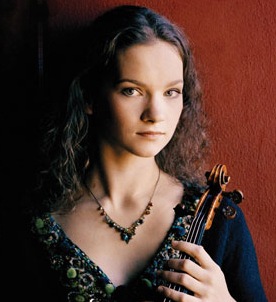
Hilary Hahn doesn’t need much introduction; as one of the leading violinists today, many of you have any number of her recordings or have been lucky enough to catch her in concert.
Usually we put our stars up on some pedestal, always with that remove of the stage between us. But Hilary herself has a different idea of what a star should be up to in between wowing folks at those concerts. She happens to love to talk to people, especially other musicians, and is genuinely interested in what makes them tick. And she loves to share what she hears with us, often using her own trusty laptop to record her interviews. As she says: “Through interviewing, I find out things about people which would never come up in casual conversation: how they work, what their creative processes are, how they view their artistic output, what they value in their professions, and so on. To me, those topics are fascinating.”
Hilary was especially interested in doing a whole series of interviews with contemporary composers; since that’s what s21’s all about we thought “why not hook up?” So here’s the deal: each month Hilary will be visiting with a different composer, posting the interview to her YouTube channel. We’ll let you know as soon as each goes up, give you the first part here and guide you to the place to view the rest. We’re really happy to work with Hilary, and to bring a bit of “real people” to the sometimes too-serious perception of our “art”.
First up, Hilary paid a visit to Judd Greenstein, a composer who’s not only been getting a lot of acclaim for his music, but is also one of the founding forces behind the exciting, young and extremely buzz-worthy New Amsterdam recording label. Hilary and Judd discuss self-presenting, artist-driven labels and the indie classical scene:
[youtube]http://www.youtube.com/watch?v=rm42bhkvTEc[/youtube]
For the rest just head on over to Hilary’s YouTube channel.
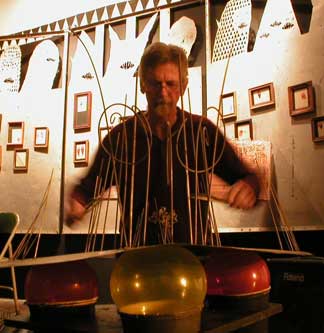 I’ve been working so hard today I’ve forgotten to eat, and it’s in that spirit of lightheadedness and poor impulse control that I share with you the following San Francisco Bay Area new music scene update.
I’ve been working so hard today I’ve forgotten to eat, and it’s in that spirit of lightheadedness and poor impulse control that I share with you the following San Francisco Bay Area new music scene update.
The Lab’s 25th anniversary performance series is well underway, and in just one night, they’ll run the gamut of styles celebrating their audacious artistic vision. On Thursday, July 2nd, Mills College’s own Chris Brown will curate and perform in a concert featuring Charles Johnson, Chad and Curtis McKinney, Tom Nunn and William Winant.
When Johnson et. al. take the stage, you’ll hear amplified string and percussion instruments tuned in just intonation, combined with analog electronics configured to create difference tones. Chad and Curtis McKinney are twin brothers whose SuperCollider-based computer network music makes a tightly interwoven, visceral and strongly rhythmic combo. Chris Brown will put on his electroacoustic hat, teaming up with instrument inventor Tom Nunn to tangle with legendary percussionist William Winant.
If you can’ t make it this week, never fear, since the series will continue next week with Miya Masaoka and Tomas Phillips on Thursday, July 9th, and a multimedia event the next night with Nao Bustamante, Margaret Tedesco, and Cliff Hengst. Performance artist Bustamante will embody 1940s Dominican movie starlet Maria Montez, using video and the body as a source of backdrop, narrative, and emotion, taking audiences on a journey all over the body and its bejeweled parts.
The Lab is conveniently located at 2948 16th Street, San Francisco, near the 16th and Mission BART station. They’ll let you in for $8.00 at the door. For more information, call (415) 864-8855.
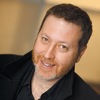
Brad is another musician who needs little introduction to S21 readers. He has worked with a seemingly endless list of ensembles across the United States and Europe, primarily as a conductor, but also as a composer. I caught up with him between Signal rehearsals in a Greenwich Village coffee shop.
The thing I love about this episode is that Brad has an almost Zen-like attitude about meeting and working with composers. He really wants us to be open to anything and everything, to be as receptive as possible, and to take it all in. You’ll want to listen to his thoughts on the “age of the masterpiece” – is it over or just getting started?
You can listen to the audio now by clicking here. For more information about the podcast you can always check-out the website.
Continuing a theme: earlier this week I mentioned a gig by composer Matt McBane’s “not-quite-neo-alt-rock-chamber-folk-etc” ensemble Build. The pattern continues this Sunday at The Stone in NYC (corner of 2nd street and Ave. C, $10), when two more “NQNARCFE” groups show us what they’ve got (is this the true wave of classical music’s future? — composers and performers each with their own group playing clubs? To try both sides of the pie, since our own side’s filling is getting decidedly skimpy?).
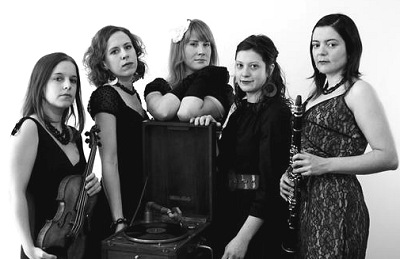
At 10pm Victoire takes the stage: “Brooklyn-based band founded by composer Missy Mazzoli (keyboards and compositions, with Olivia De Prato and Andie Springer, violins, Eileen Mack, clarinet, Lorna Krier, keyboards and Eleonore Oppenheim, double bass) has been dubbed an ‘all-star, all-female quintet’ by Time Out New York. This quirky ensemble combines strings, clarinets, keyboards and lo-fi electronics (including samples of sewing machines and answering machine tapes) to create their ‘minimalist, post-rock bliss’.” Their EP has been getting a great reception, and chances are good that you’re going to hear about them far into the future.
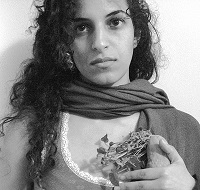
Opening the night at 8pm, Odeya Nini stamps her own group with a rather different vibe. As Odeya tells me herself, “...my current work is a bit different – I guess its just a piling up of more experiences, mind tumbles and turns. My music could be categorized as indie chamber / electronic / folk — or simple music for folks to focus and indulge in what they might perceive as cohesive or opaque.”
Odeya “received her BFA in vocal performance from the New School for Jazz and Contemporary Music where she studied voice with Theo Bleckmann and composition with Kirk Nurock and Gerry Hemingway. Today her work is characterized by skillful experimentation, integrating improvisation, acoustic composition and electro-acoustic sounds to create thought provoking works of art.”
She’ll be working with her own group of sidekicks : Alex Hills (piano), James Ilgenfritz (bass), Jake Wise (clarinet), Katie Young (bassoon), Elena Moon Park (violin) and Curtis Stewart (violin). This is one of Odeya’s last gigs in NYC before she relocates out West for grad school composition study.

S21 friend Peter Mueller passed along the good news that:
The Library of Congress has completed digitization of another batch of the compositional sketches of Elliott Carter. These are now available on our web site. This current release consists of the following material:
Pocahontas (18*)
Symphony No.1 (224)
Piano Sonata (20*)
Minotaur (108)
Emblems (192)
Woodwind Quintet (141)
Eight Etudes and a Fantasy (140)
Sonata for Flute, Oboe, Cello & Harpsichord (51)
Variations for Orchestra (771)
Double Concerto (161*)
For technical reasons, these are not all complete yet. Numbers in parens indicate page (image) counts; an asterisk indicates digitization is incomplete (more to come in future releases).
There will be either one or two more releases in the near future to complete this project. Comments are welcome. Please email these directly to me at
ssod@loc.gov
Stephen Soderberg
Senior Specialist for Contemporary Music
Music Division, Library of Congress, Washington, DC